Ohio is a birding paradise. It'll have you exploring all corners of the state for sightings of over 400 bird species.
Some of these are rare, such that you'd take a few days or months to see them in any birding zone.
Then we have wild birds that come to the bird feeders searching for suet or black oil sunflower seeds.
We'd love to list all Ohio birds, but...
We know you have an upcoming birding tour to see wild birds; thus, we won't take much of your packing time. Let's go right into:
Ohio Birds To See Today
1. Brown-headed Cowbird
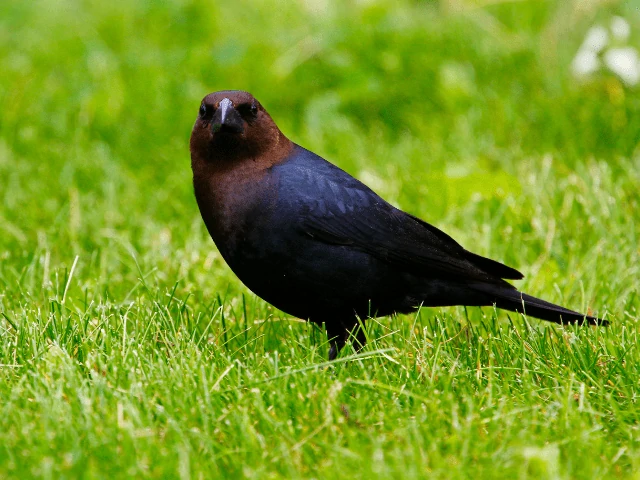
Birders also call it the Molothrus ater. It's not such a large bird as the male is about 7.5 to almost 9 inches long, and the female doesn't grow longer than 7.9 inches. The wingspan ranges between 14 and 15 inches for both sexes.
You'll tell it apart from other Ohio birds by its shiny bluish-black plumage. The plumage of the female species appears brownish-black. It must love nesting in the homes of others as it can lay eggs in the nests of over 200 species. What a parasite!
Yes, the brown-headed cowbird comes to backyards, more so if it's an open field. It also hangs out with livestock, and that's how it got the name cowbird.
Backyard Feeder Visits
Yes
Sightings
All-year-round sightings. There are more between March and July.
Food
Delectables are grasshoppers, grass, weeds, crop grains, bird eggs, and snail shells.
2. Indigo Bunting
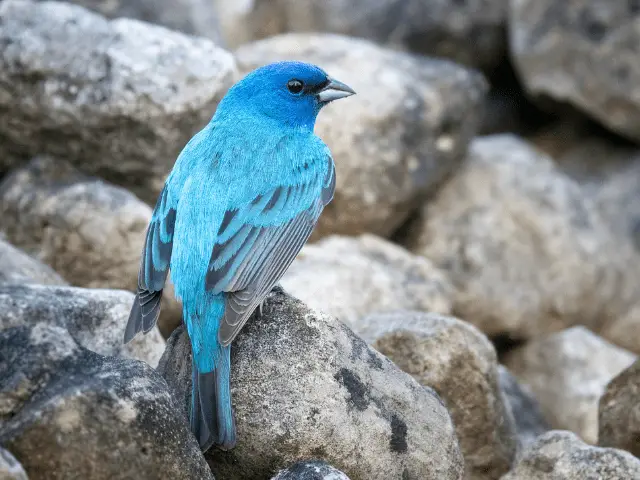
If you spot a bird that's indigo blue, about 5 inches long, and its wingspan is between seven and nine inches, it's most likely an indigo bunting. But that's if you see the male bird first because the female has brown plumage and a white underbelly.
This bird consumes seeds, though it also eats a few other foods. The indigo bunting lives on the edge of woodlands and open fields. More habitats to search are along rivers and highways.
Bird Feeder Visitor
Yes
Sightings
Breeding population between March and October
Food
This bird species eats seeds, insects, berries, and buds.
3. Tree Swallow
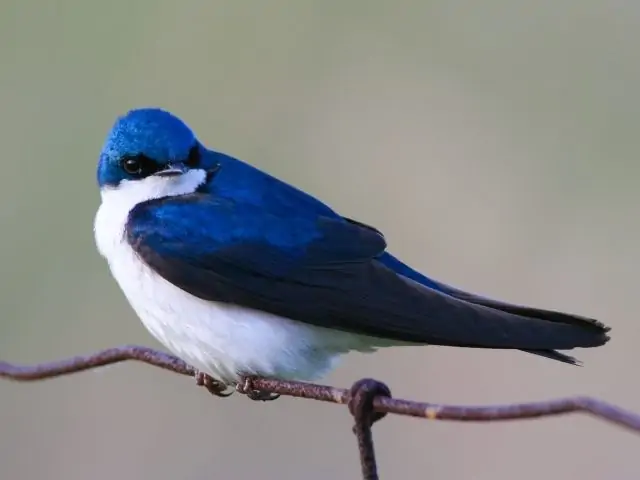
Unlike the indigo bunting, the tree swallow has a darker shade of blue on its back and a white underbelly. Females also have a shiny back, but instead of a bluish-black one, theirs is brownish blue.
The tree swallow also comes to bird feeders in your backyard, so you don't have to look for it in marshes and wooded swamps. It nests in old trees or bird boxes, and you'll spot thousands of this bird species migrating in a flock.
Backyard Feeder Visitor
Yes
Sightings
The breeding season between March and November
Food
Favorites include insects like beetles, butterflies, moths, dragonflies, bees, and ants.
4. Yellow-rumped Warbler
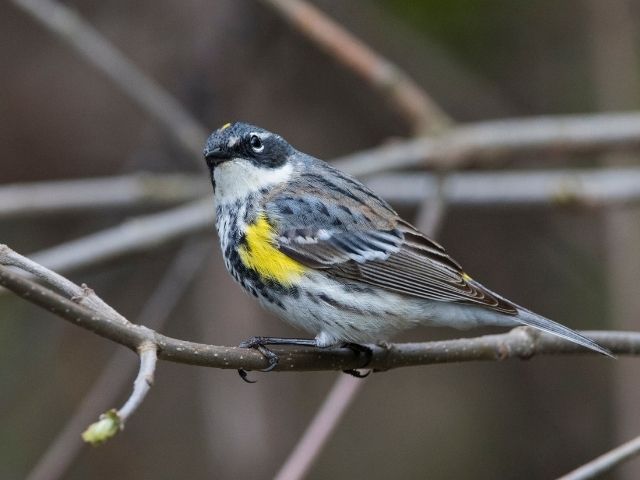
Oh! You'll love seeing this bird through your binoculars. Its male has a black mask, yellow patches on its underbelly, and a white throat. Audubon sighted a male bird with a yellow throat and yellow patches on the underside.
It’s between 4.7 and 5.5 inches long, and its wingspan can reach 9 inches. Unlike other warblers, it can digest wax in bayberries and other fruits. Therefore, it can winter north where others can't.
Bird Feeder Visits
Yes
Sightings
All year round, more so between September and March.
Food
It hunts and gathers caterpillars, bark beetles, grasshoppers, crane flies, spiders, seeds, plus fruits.
5. White-throated Sparrow
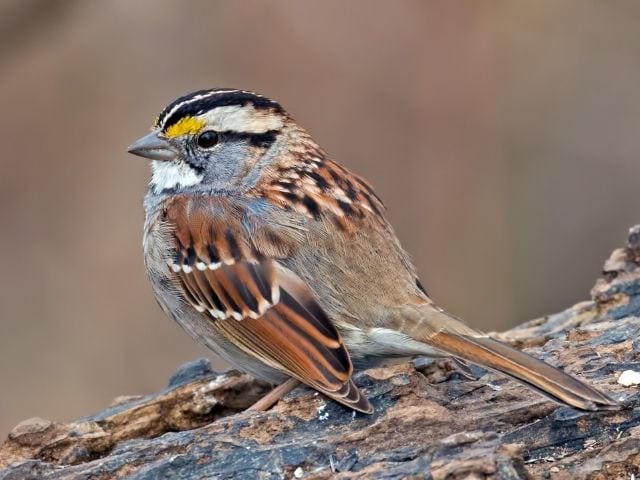
It's other name is Zonotrichia albicollis. The white-throated sparrow is a songbird and a resident bird in Ohio.
A white throat distinguishes it from other bird species, coupled with its plump shape and a small bill. The underbelly has a gray underbelly and a tan-striped back. The adult white-throated sparrow may have a yellow spot above the eye. Strangely, this bird can mate with the dark-eyed junco leading to nestlings with grayish birds, plus white outer feathers.
The white-throated sparrow searches for food in leaves, so it's almost always near the ground. In spring, it may stay in low bushes to enjoy the abundant buds.
Other habitats for this sparrow are the edges of ponds and bogs. Do you have such habitats nearby? But you can skip the trips to woodlands and attract the white-throated sparrow to your yard with millet and sunflower seeds.
Backyard Visitor
Yes
Sightings
All year round
Food
It’s a good day when it eats worms, berries, herbs, millet, beetles, caterpillars, centipedes, and snails.
6. Field Sparrow
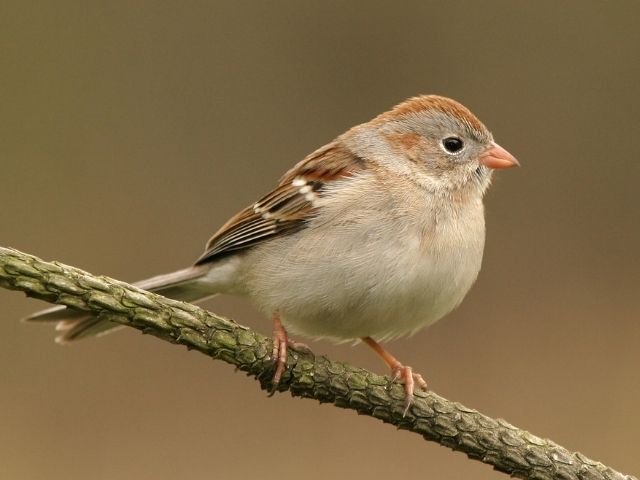
It's a small bird that's about six inches long and weighs 12 grams. Its other name is Spizella pusilla, and to ID it, look for black eyes, a pink bill, and rusty plumage with a white underbelly. There's a white circle around the eyes, and some birds have a brown or black-streaked back.
You can spot it in its nest in summer as that's the breeding season. Therefore, search for nests on small trees and in the bushes. You don't have to go far as it explores bird feeders, and you'll spot a few of them in populated areas.
But, they don't breed near humans. The male's love language includes a high-pitched call, which it also uses to declare its territory.
Backyard Visits
Yes
Sightings
All year round
Food
Favorites include insects, snails, butterflies, spittlebugs, weevils, bees, beetles, caterpillars, and flies.
7. Red-bellied Woodpecker

You may attract it if you serve some suet regularly or there are dead trees on your property. It has a sticky spit that snatches insects in tree crevices. The tongues of both the male and female red bellied woodpecker are almost two inches long. Wow!
It's medium-sized compared to other Ohio birds. You'll spot a male by its white and black barred back, a pale belly, and a reddish nape and crown. However, the female red-bellied woodpecker doesn't have a reddish crown.
The male attracts mates with its high-pitched call. Unfortunately, it doesn't breed anywhere in the US, not even in Ohio. But, you can spot a resident population.
Backyard Visits
Yes
Sightings
All year round
Food
It’s not a bad day when it has seeds from fruits, nuts, pine cones, and acorns. It may also hunt nestlings and lizards.
8. Cedar Waxwing

This one is not going anywhere, so you can spot it in Ohio any time of the year. It's a medium-sized bird that grows seven inches long and boasts a wingspan of up to 11 inches.
This small waxwing has a high-pitched call that's unmistakable in the woodlands, grasslands, and mixed forests it inhabits. Its name represents its love for cedar berries, though it also eats other fruits and insects in summer.
The second name, waxwing, comes from the appendage on the secondary feathers. If you want to attract the cedar waxwing to your bird feeder, grow trees with small fruits like winterberry and juniper.
It has a gray back, pale brown head, and a light underside. Plus, its face has a distinct white outline around a black mask.
Backyard Birds
Yes
Sightings
All year round
Food
They include strawberries, raspberries, juniper, mountain ash, mulberry, dragonflies, spruce budworm, and mayflies.
9. Downy Woodpecker

It’s a resident bird, so you'll see it in Ohio whichever time you go birding. There's a greater likelihood of spotting this bird than the cedar waxwing. This small bird species is between five and seven inches long. Its wingspan is somewhere between 9.8 inches and 11.8 inches.
Beyond looking at its size, you can also ID it by its unique plumage. The male in the Eastern region has a short bill, a white back, a white underbelly, and white spots on its wings. Since white is the dominant color, the head of the downy woodpecker is white with black stripes and a red patch on its nape. However, the female bird has a grayish underside.
Backyard Birds
Yes
Sightings
All year round
Food
Beetle larvae, ants, caterpillars, grains, suet, berries, and acorns are favorites.
10. Northern Cardinal

Like most species we'll talk about here, the northern cardinal is a songbird, and you can identify its stunning plumage anywhere in the forest. But that's when you see a male bird first, as it has bright red plumage. Some more ID details of a male northern cardinal are a long tail, striking crest, and thick bill.
A female is so different you'll wonder whether it belongs to the same species. Instead of red plumage, the female has a pale brown underside. Further, it has a reddish crest, wings, and tail.
You're likely to spot it in Ohio as it's a resident. In birding journals, another name for it is Cardinalis cardinalis.
The female is one of the few songbirds of North America that sing, and it sings to tell the male bird when to bring food.
Backyard Bird Species
Yes
Sightings
All year round
Food
The northern cardinal likes butterflies, wild grapes, buckwheat, moths, centipedes, sumac, corn, and black oil sunflower seed.
11. Blue Jay

You'll rarely miss a blue jay in a suet feeder. Or maybe you saw it once but couldn't ID it. Well, the next time you spot a small bird with a wingspan of between 13 and 17 inches, a white chest, and a blue back, it might be a blue jay.
Its feathers have melanin that gives it a brown pigment, and the blue color comes from scattered light on the feathers. This large songbird also has a striking crest and a black stripe on the throat that looks like a necklace.
Its other name is Cyanocitta Cristata, and it loves woodlands. The blue jay is so intelligent that it can mimic the call of a red-shouldered hawk in Ohio to warn other blue jays about this predator.
Backyard Birds
Yes
Sightings
All year round
Food
The blue jay enjoys nuts, grains, acorns, dead birds, eggs, and nestlings.
12. Tufted Titmouse
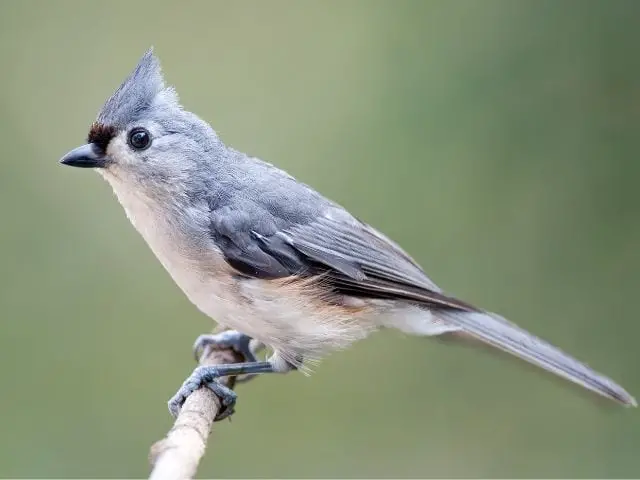
Another name for this species is Baeolophus Atricristatus. It's a mouthful, but since you want to ID birds, learn as much as you can about these feathered friends so you can even join the Audubon Society. The tufted titmouse is a songbird, a resident of North America, and you can see it in this state all year round.
This bird has striking plumage with a gray back contrasting a white belly. Other ID details are a crest and dark eyes. Do you think you might have spotted the tufted titmouse already?
When it arrives in your backyard, the tufted titmouse gathers seeds from your bird feeder and carries them to a storage area nearby. So, if you want to know if these backyard birds are visiting your hopper feeder, look for a pile of unshelled seeds stored about 130 feet from your backyard feeders.
Wouldn't it be exciting to see it pick seeds, one at a time, and carry them to the secret stash?
Backyard Visitor
Yes
Sightings
All year round
Food
The tufted titmouse likes grains, the seeds of plants, berries, insects, nuts, caterpillars, and wasps.
13. The Red-Winged Blackbird
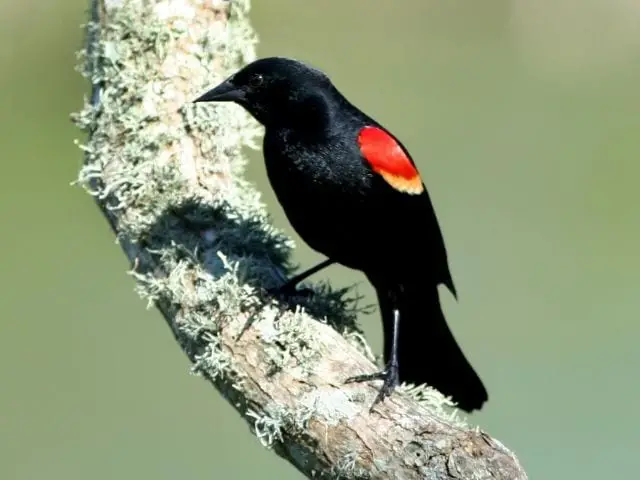
If you forget the name red-winged blackbird, you can call it Agelaius phoeniceus. Unlike the tufted titmouse, this one has black plumage with a splash of red on the shoulders. The female, however, has colorful red shoulders with a brownish, yellowish border.
The male bird can have over a dozen mates, and it's very territorial. The red-winged blackbird is so fierce when breeding that it defends its nest from humans or animals like horses.
Sometimes, it also builds nests in woodlands. The female decides where to build a nest though the male also brings some ideas. The nests are mostly a few meters from the ground or in a marsh. Such nesting grounds are now scarce, so this bird nests in sparse groups instead of flocks.
Suet Feeder Visits
Yes
Sightings
All year round
Food
It loves berries, insect larvae, seeds, worms, spiders, and cracked nuts.
14. Swamp Sparrow
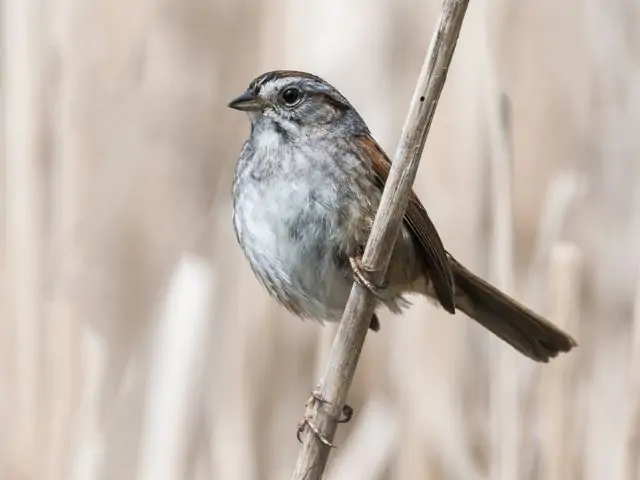
This sparrow is a medium-distance migratory bird with both resident Ohio birds and a large nonbreeding population.
The adult has a rounded tail, a gray face with a dark line, a gray collar, rusty underbelly, and reddish wings. The nonbreeding adult swamp sparrow has a paler underbelly with reddish wings.
Backyard Visits
Yes
Sightings
The resident population in the north
Food
It eats dragonflies, ants, aphids, bees, blueberries, wasps, caterpillars, grasses, and smartweed.
15. Mourning Dove

You'll know it's a mourning dove if it has rusty brown plumage with a few black spots on the back. Its underside has pale peach tones, and its feet are pink.
The mourning dove is one of the backyard birds because it visits bird feeders; hence, you can list it among the ones you'll spot at home.
The only place you'll not find it is in the deep woods. It even perches on telephone lines. You may not tell the male and female birds apart at first glance as they have a similar wingspans.
The mourning dove nests in dense foliage on trees, but it may also nest on the ground. Since it doesn't worry about disturbances, it can nest in gutters.
Backyard Visits
Yes
Sightings
All year round
Food
The diet includes crop grains, wild grass, and herbs. Occasionally, it eats snails and berries.
16. House Sparrow

It's one of the most common wild birds in this state, and it even comes to bird feeders. It’s small, weighing about 30 grams, and both sexes are between 5.9 and 6.7 inches long. It's almost the size of a song sparrow but bulkier.
It loves human settlements, often displacing other birds from nest boxes. That's one of the reasons most backyard birders don't like them. This interaction also influences its food as it can eat livestock feed or human food in garbage bins.
You'll know it's this sparrow if the male has a gray crown and white cheeks contrasting a black bib. The female bird has a stout bill too, but its back is paler, while its underside is grayish brown.
Backyard Visits
Yes
Sightings
All year round
Food
They include wheat, corn, crabgrass, buckwheat, insects, sunflower seeds, and ragweed.
17. House Finch

You can use its more technical name, Haemorhous mexicanus. Like the house sparrow, it's also very social and loves inhabited areas and backyard feeders. This finch is one of the resident Ohio birds with year-long sightings.
To know you're looking at one, watch out for a rosy red color on the face extending down to the breast. If it's a female finch, it'll have grayish-brown underparts and a notched bill like the male.
Backyard Visits
Yes
Sightings
All year round
Food
This finch’s diet includes cherries, cactus, peaches, knotweed, poison oak, and black oil sunflower seeds.
Also...
Other popular bird species you can have on your watch list are the American woodcock, cerulean warbler, wood duck, ruby-throated hummingbird, white-breasted nuthatch, trumpeter swan, pileated woodpecker, summer tanager, song sparrow, black-capped chickadee, and the northern harrier.
Which Ohio birds have you seen so far?
If these wild birds don't come to your suet feeder, go birding.
Here are:
The Best Places To See Ohio Birds
This state has three wildlife refuges and eight national parks totaling over 3 million areas of birding zone. Wildlife experts list the following as the best places to see bird species in Ohio.
Magee Marsh Wildlife Area
It's on Lake Erie, which is one of the five largest in North America. Therefore, it's a destination during the spring migration.
Killdeer Plains Wildlife Area
Even in winter, there's enough excitement for birders in the over 9,000-acre area. It has vast grassland, so you can spot the species we mentioned as inhabiting grasslands. You're likely to see the nests of the trumpeter swan and the bald eagle in the open areas.
Sheldon Marsh State Nature Preserve
It has various habitats like a hardwood forest, a sandy beach, a marsh, and a wooded swamp. Do you know which bird species you can spot in such environments?
Watch one of the Ohio birds, the Red-winged Blackbird in this video:
Frequently Asked Questions (FAQs)
What are the rarest birds in Ohio?
There are many rare ones, such as the tufted duck, black-chinned hummingbird, northern goshawk, and the white ibis.
Where are the warblers in Ohio?
They inhabit the northeastern part of Ohio in spring. If you'd like to spot over 30 species, go birding in the Lake Erie area, explore the over 80 acres of Lakeshore Reservation, and visit Magee Marsh Wildlife Areas or Wendy Park. Use ID details like facial patterns and plumage color to differentiate them.
What are the most common birds in Ohio?
They include the American robin, blue jay, common grackle, American goldfinch, and most cardinals, such as the northern cardinal. These birds love backyard feeders, and you can make their stay more exciting with birdbaths.
What songbirds are in Ohio?
They include the tree swallow, the house finch, the European starling, and the house sparrow. You can attract them to your backyard using a suet feeder and birdbaths. However, some songbirds also attract predators that'll dominate the feeders.
Final Thoughts
There are two places to see Ohio birds. You can opt to see bird species that frequent the bird feeders or go birding. If you choose the former, you'll spot backyard birds like the downy woodpecker and the northern cardinal, among others we listed earlier.
If you go to the birding parks and nature reserves, you'll see wild birds in diverse habitats because this state has many birding parks and nature preserves. Remember, you have over 400 species to see.

